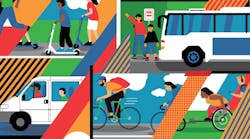OP-ED: Handholds and Training Wheels: Shifting more households to using shared mobility
Agartha Frimpong, a 60-plus-year-old Ghanaian woman known affectionately as Mama Agatha, runs a bicycle training program in southeast Amsterdam. Frimpong and her team at Stitching Women Motivation & Integration teach migrant and refugee women how to ride a bicycle, a critical skill in one of the most bike-friendly cities in the world (I learned about Mama Agatha and the women she trains through Fadi Hindash’s award-winning documentary of the same name. You can catch the 15-minute clip on YouTube.) Frimpong’s program recognizes that you could live in a world-class cycling environment and even own a bike, but that does you no good if you don’t know how to ride a bike or understand the rules of the road. Providing shared mobility infrastructure and shared mobility services is often not enough.
What’s key to Frimpong’s success is she took the time to meet the women where they’re at. We must listen to and understand our communities’ unique needs to offer the proper tools, resources and incentives when providing services that move people towards shared mobility and away from car ownership. The Shared Mobility 2030 Action Agenda calls us to create and use accessible products and incentives to help households shift to more shared mobility.
“We need to engage and listen to communities to understand the social, financial, historical and cultural contexts of the households and neighborhoods. We need to pay particular attention to informational divides where households and communities may lack sufficient access to technology, access to the internet or need the information in different languages or channels. We need to understand before we act, especially if the communities have been traumatized by injustice and inequity.”
Another example that illustrates why it’s important to understand the community when creating products and incentives for shared mobility is in Chicago with Equiticity. Equiticity teaches black and brown children and adults to bike in their own neighborhoods through the Community Mobility Rituals. This is critical, particularly in communities that have suffered the trauma of transportation investments that tore up neighborhoods and still suffer from over-policing and over regulation (Not to mention, black cyclists die from traffic accidents 25 percent more than their white counterparts).
Equiticity says the rituals “contribute to increased social cohesion and collective efficacy at the neighborhood level” and leverages social relationships and culture in transportation programs.
"When culture is infused into the process, black and brown people in particular will feel a deeper connection to it, and when the approach is to just plop a bike lane down in a neighborhood, with little community ownership and little culture and history infused [into that process] — it literally contributes to the resistance against the bikeway," explains Equiticity President and CEO Olatunji Oboi Reed in Kea Wilson’s “The Brake” podcast.
Like metaphorical training wheels, their programs introduce people to new services and new ways to get around. As I said in my first piece in this series, because we’re marinated in “the car is the only option to get around,” in shared mobility, as in many things in life, “if you build it, they will come” does not hold true, especially if you want to break down the barriers of inequality.
It’s not enough to provide apps if households can’t afford internet access. It’s not enough to provide bus schedules and bus maps or shared car parking and parking signs. We also need to provide easy to understand guides on how to navigate the bus system or how to book a bike or scooter and maps of where it is safe to ride. We need to provide incentives that make it easier for people to choose shared mobility and to understand the outsized costs of car ownership.
We often miss the teaching step in our privilege. Even in a bike-oriented city like Amsterdam, there can still be people who experience barriers to mobility because we assume everyone has the knowledge and tools needed to get around. This is something Fadi Handish only learned to appreciate when he began documenting Mama Agatha’s work. When asked, “Do you think learning how to ride a bike is especially important for women?” Handish answered, “Before making [the documentary] Mama Agatha, I didn't realize how much cycling meant to people, especially women, in need of freedom and independence. I learned that the physical mobility cycling provides actually comes with social mobility and personal freedom, not to mention the childlike joy it brings to the kind of women that are in my film.”
If we want to free more people from transportation insecurity and the burdens of car ownership, we need to provide the handholds, the tools and incentives that help people to access public transportation, bike-shares and scooter shares, on-demand microtransit, ride hail, car share and all the other services that allow us to get around without having to own a car. We need to think about tools, incentives and the human interaction that can bring joy and learning when using shared mobility.
---------------------
Benjie de la Peña is the CEO of Shared-Use Mobility Center.

Benjie de la Peña | CEO, Shared-Use Mobility Center (SUMC)
Benjie de la Peña is the CEO of the Shared-Use Mobility Center; he chairs the Global Partnership for Informal Transportation; founder of Agile City Partners; and writes and curates Makeshift Mobility, a fortnightly newsletter covering innovations in informal transportation. He also convenes the Shared Mobility 2030 Action Agenda and edits and produces Pop Transport.
He serves on the board of the American Council for an Energy-Efficient Economy (ACEEE), the U.S. Advisory Committee of the Institute for Transportation and Development Policy, the UITP Informal Transportation Working Group, the Digital Transport for Africa Partners Committee, the MobiliseYourCity Steering Committee and is a senior fellow for mobility for the Canadian Urban Institute.
He served as the first-ever chief of strategy and innovation for the Seattle Department of Transportation. He and his team drafted the city’s Transportation Information Infrastructure Plan. He also led the development of Seattle’s New Mobility Playbook.
He served on the advisory committees for L.A.’s Transportation Technology Strategy, the Mobiprize and Cooper Hewitt Museum’s The Road Ahead: Reimagining Mobility and Design with the Other 90%: Cities.




